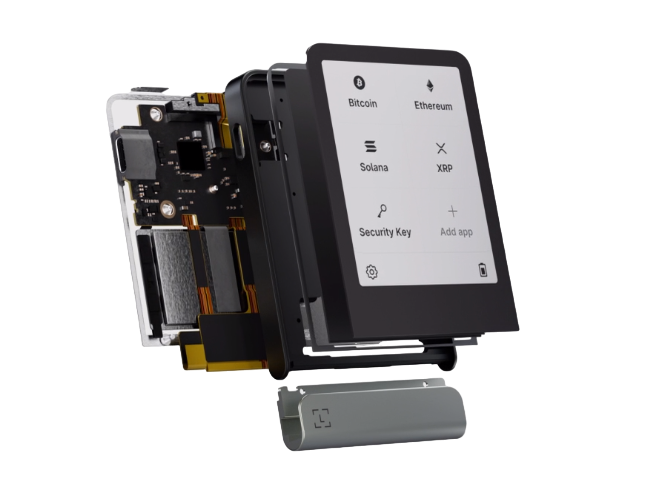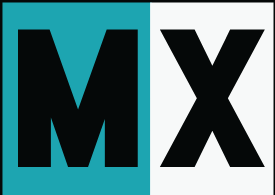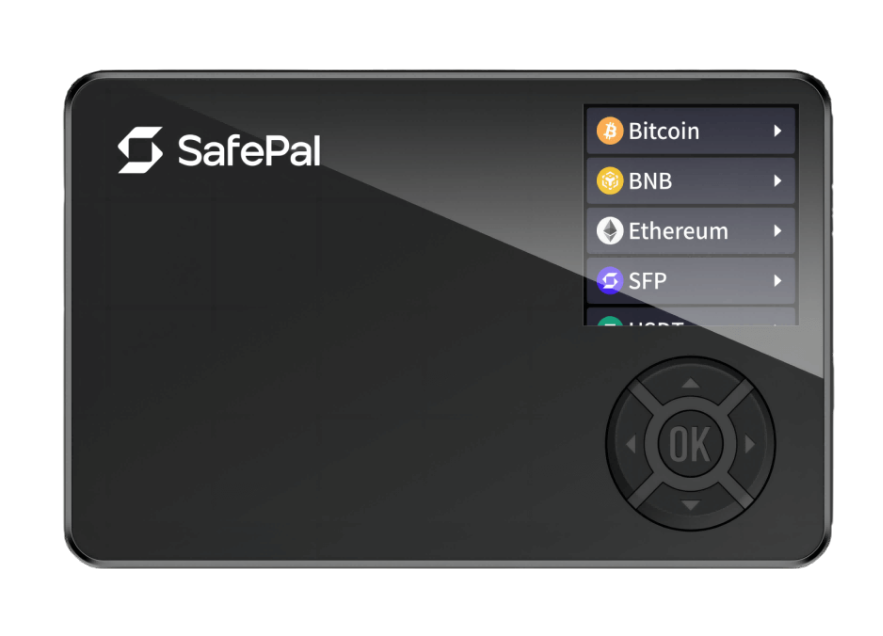
When considering a hardware wallet to buy in 2025, you might be given the options between SafePal S1 vs Ledger Flex. You need security, ease of use, and features that suit your needs. SafePal S1 offers reliable security at an affordable price, while the Ledger Flex boasts more premium features. This comparison will help you decide which wallet is right for you based on your preferences.
SafePal S1 vs Ledger Flex – Side-by-side comparison
Feature |
SafePal S1 |
Ledger Flex |
|---|---|---|
Price |
~$49.99 USD |
~$249 USD |
Security |
(CC EAL5+), Air-gapped, QR code transfers, AES-256 encryption |
Secure Element chip (CC EAL6+), Ledger OS |
Connectivity |
QR code, no Bluetooth, no USB |
Bluetooth® 5.2, USB-C, NFC |
Supported Cryptocurrencies |
9,000+ major cryptos, ERC-20 tokens |
5000+ cryptos including ERC-20, BTC, ETH, SOL, and more |
Support for NFTs |
No direct support for NFTs |
Supports Ethereum and Polygon NFTs on Ledger Live |
Dimensions |
87mm x 55mm x 10mm |
78.4mm x 56.5mm x 7.7mm |
Weight |
47g |
57.5g |
Box Contents |
SafePal S1 device, USB-C to USB-A cable, 1 recovery sheet |
Ledger Flex device, USB-C to USB-C cable, Recovery Sheet |
SafePal S1 vs Ledger Flex – Overview
The SafePal S1 is a budget-friendly, secure hardware wallet designed with a simple yet effective approach to crypto storage. Manufactured by SafePal, a Singapore-based company known for providing affordable and secure crypto solutions, the S1 is perfect for users who want top-tier security without breaking the bank. It relies on a QR code system for transactions, keeping it fully offline and reducing any exposure to online threats. SafePal’s focus is on offering a hassle-free experience while maintaining high security standards, and the S1 fits this mission well.
The Ledger Flex, on the other hand, represents the cutting edge of hardware wallet technology. Released by Ledger, the French company that pioneered hardware wallets like the Nano S, Nano X, and Stax, the Flex introduces a revolutionary 2.84-inch E Ink® touchscreen, making it the world’s first secure touchscreen hardware wallet. Unlike the SafePal S1, the Flex offers a premium user interface, combining functionality with style. It supports Bluetooth® connectivity for seamless management of your assets, giving it a more user-friendly edge, especially for those who prefer a more interactive wallet experience.
Pricing
When it comes to pricing, You can get the SafePal S1 at around $49, making it one of the most affordable hardware wallets on the market. Given its robust security features, ease of use, and impressive battery life, the S1 is an excellent choice for anyone looking for a simple, reliable wallet at a budget-friendly price.
The Ledger Flex, priced at $249, is a more premium option, reflecting its advanced features such as the E Ink® touchscreen, multi-device compatibility, and Bluetooth connectivity.
While it’s significantly more expensive, the added features and convenience of a modern, secure wallet make the Ledger Flex a compelling choice for users who want the best of both security and user experience. For users who prioritize high-end functionality, the Ledger Flex offers excellent value, even at a higher price point.
Design and Build Quality
The SafePal S1 has a minimalistic and compact design, making it easy to carry around. Its sturdy plastic body (ABS + PVC housing material) is lightweight, yet it feels durable. At 74mm x 34mm x 10mm and weighing only 50g, the S1 is portable and practical, with a display that’s just large enough for basic navigation and QR code scanning. Its compact design also incorporates a D-pad button for easy navigation, offering a tactile and straightforward interface. It’s just perfect for those who value simplicity and portability.
In contrast, the Ledger Flex is a more premium device with an eye-catching design. The wallet features an aluminum frame, Gorilla Glass screen cover, and a plastic back, giving it a sleek and durable build. At 78.4mm x 56.5mm x 7.7mm and weighing 57.5g, it is slightly larger and heavier than the SafePal S1 but still portable. Additionally, the Flex includes a magnetic folio for extra protection and customization, making it a stylish yet functional option for those looking for something more than just a wallet.
Both wallets have a solid build, but the Ledger Flex definitely appeals to those who want a more visually sophisticated device with a premium feel. If portability and simplicity are more important to you, the SafePal S1 is the better choice.
Display and User Experience
The display is where the Ledger Flex truly shines, featuring a 2.84-inch E Ink® touchscreen with a Gorilla Glass screen cover and an anti-glare coating for optimal viewing in any lighting condition. This display isn’t just larger; it’s more intuitive, offering a seamless tap-and-swipe experience.

The ability to personalize the screen with your favorite NFT or image and have them display even when the wallet is turned off also adds a touch of uniqueness. This makes the Ledger Flex a delight for those who value aesthetics and usability. This wallet also offers sound feedback for every interaction and supports 16 scales of gray, making navigation seamless and visually clear.
On the other hand, SafePal S1 keeps it simple with a 1.3-inch color screen and a 320×320 resolution. While it’s smaller, it gets the job done for displaying essential information, especially in its secure offline environment.
If display clarity and modern interaction are your priorities, the Ledger Flex leads the way.
Connectivity Options
When it comes to connectivity, both the SafePal S1 and Ledger Flex offer distinct advantages, making them appealing to different types of users.
As mentioned earlier, one of the unique features of SafePal S1 is its air-gapped technology, meaning it never connects directly to the internet. This significantly reduces the chances of hacking. The SafePal S1 uses QR codes to transfer data between the wallet and its mobile app, which adds another layer of security by avoiding direct USB or Bluetooth connections. It’s compatible with iOS and Android, making it easy for most users to integrate it into their existing crypto ecosystem. However, it doesn’t support Bluetooth, which can be a deal-breaker for users who want more modern and wireless features.
On the other hand, the Ledger Flex offers far more advanced connectivity options. It features NFC and Bluetooth® 5.2 that allows you to easily pair it with your smartphone (iOS or Android) for a seamless, wireless experience. You can also connect via USB-C to your desktop or laptop for more control and versatility. The Ledger Live app, which is compatible with Windows, macOS, Ubuntu, Android, and iOS, offers a user-friendly platform for managing your crypto portfolio.
For users who value a more interactive experience and multiple connection options, the Ledger Flex is the clear winner.
SafePal S1 vs Ledger Flex – Security Features
When it comes to security, both the SafePal S1 and Ledger Flex prioritize protecting your digital assets but take different approaches.
The SafePal S1 is highly secure because it is built with an EAL 5+ secure element. It is also air-gapped, meaning it has no direct internet connection, Bluetooth, or Wi-Fi, making it nearly impossible for hackers to access. It relies on QR code-based transactions for maximum offline security. This wallet also stands out with its multiple layers of security sensors, which work together to protect your assets. It also features an anti-tampering self-destruct mechanism—a critical safeguard that wipes the wallet’s data if any physical breach is detected, ensuring your crypto remains secure even in worst-case scenarios.
The Ledger Flex, on the other hand, offers robust security powered by its CC EAL6+ certified Secure Element chip and Ledger OS.

It introduces the Ledger Recover service as an optional backup solution, providing peace of mind if you misplace your recovery phrase. A standout feature is its Clear Signing capability, which allows you to review all transaction details directly on the E Ink® touchscreen in human-readable language before signing. This ensures complete transparency and minimizes risks, giving you full control over your transactions.
As you can see, both wallets excel in safeguarding assets, but the choice depends on whether you value self-destruct mechanisms or advanced recovery options.
Supported Assets and NFTs
Both the SafePal S1 and Ledger Flex support an impressive array of cryptocurrencies, making them versatile wallets for any crypto enthusiast.
The SafePal S1 manages over 9,000 cryptocurrencies, including popular options like Bitcoin (BTC), Ethereum (ETH), Binance Coin (BNB), and Solana (SOL). Additionally, it supports NFTs across multiple blockchains, including Ethereum and Binance Smart Chain.
The Ledger Flex also offers extensive asset compatibility, managing over 5,500 digital assets and tokens natively, such as BTC, ETH, XRP, and SOL, with support for Ethereum and Polygon NFTs through Ledger Live app. With third-party wallet integrations, this range expands to thousands of coins and multi-blockchain NFTs.
So whether you need broader crypto support or specialized NFT functionality, both wallets cater to diverse needs, though Ledger Flex’s sleek integration with Ledger Live provides a polished user experience..
Battery Life and Charging
Battery performance is a crucial factor when comparing the SafePal S1 vs Ledger Flex. The SafePal S1 boasts a built-in 400mAh battery, providing up to 20 days of battery life with just 10 minutes of daily usage. This impressive battery life ensures you don’t need to constantly charge your device, which is great for users who are always on the go. The charging process is simple, using a standard USB-C connection. Given its long-lasting battery, the S1 is particularly convenient for users who want to avoid constant recharging while still ensuring their wallet is always ready for use.
The Ledger Flex, however, comes with a battery life of up to 10 hours of normal use or around 150 transactions. While its battery isn’t as long-lasting as the S1, it’s still suitable for daily use. The Ledger Flex charges via USB-C, and it doesn’t support wireless Qi charging that comes with the Ledger Stax.
Despite this, the Ledger Flex provides more versatility in its usability due to its touchscreen, which requires slightly more power to support an interactive user interface. Though not as long-lasting as the SafePal S1, the Ledger Flex’s fast charging and modern display compensate for the difference, offering an engaging experience while using the wallet.
Box Contents
The box contents can set the tone for your hardware wallet experience. With the SafePal S1, you’ll find everything you need to get started: the device, a USB cable for charging, cleaning cloths, recovery sheets, and even some SafePal-branded stickers. The setup is straightforward and practical, reflecting SafePal’s focus on simplicity.
Ledger Flex, however, takes a slightly more premium approach. Alongside the wallet, you get a USB-C cable, a recovery sheet, and a sleek Magnetic Folio for protection. This magnetic accessory adds a layer of style and functionality, ensuring your wallet stays protected while exuding sophistication. If extras matter to you, Ledger Flex provides a touch of elegance and added value.
SafePal S1 Box Contents
Item |
Description |
|---|---|
SafePal S1 Wallet |
Main device for managing assets |
USB Cable |
For charging and updates |
Cleaning Cloths |
For maintaining the wallet screen |
Recovery Sheets |
For securely writing down seed phrases |
SafePal Stickers |
Fun branding add-ons |
Ledger Flex Box Contents
Item |
Description |
|---|---|
Ledger Flex Wallet |
Main device with secure touchscreen |
USB-C Cable |
For charging and updates |
Recovery Sheet |
For securely writing down seed phrases |
Magnetic Folio |
Protective accessory for the device |
Ledger Flex Guide |
Quick-start and user instructions |
Pros and Cons
Both wallets have their strengths and weaknesses, which can help you decide based on your priorities. Here’s a side-by-side summary:
SafePal S1 Pros and Cons
Pros |
Cons |
|---|---|
Affordable price point |
Lacks touchscreen for modern navigation |
Fully air-gapped security eliminates online vulnerabilities |
QR code-based process might feel outdated |
Over 9,000 supported assets |
|
Long battery standby |
Ledger Flex Pros and Cons
Pros |
Cons |
|---|---|
Intuitive and modern 2.84-inch E Ink® touchscreen |
Higher price point at $249 |
Supports Bluetooth and USB-C |
Heavier and slightly bulkier than SafePal S1 |
Premium build with Magnetic Folio included |
|
Wide support for 5,000+ third-party coins and NFTs |
SafePal S1 vs Ledger Flex: Which Should You Buy?
When deciding between the SafePal S1 and Ledger Flex, the choice should depend on what really matters to you. For example, if you’re seeking an affordable, long-lasting hardware wallet for basic cryptocurrency storage and a great user experience, then go for the SafePal S1. With its 20-day battery life, budget-friendly price tag, and robust security, it’s perfect for anyone who wants to protect their crypto assets without breaking the bank.
However, if you’re someone who wants more advanced features—such as a touchscreen interface, support for NFTs, and greater versatility—you should buy the Ledger Flex. While it comes at a higher price point of $249, it offers cutting-edge features like the customizable E Ink® display, support for a wider range of digital assets, and multi-device compatibility.
Where and How to Purchase Each Model
When shopping for a hardware wallet, it’s essential to buy directly from the official websites to ensure you’re getting a genuine, un-compromised product. Buying from resellers can increase the risk of receiving a device that’s been tampered with or used, which is a significant security risk.
For the SafePal S1, purchasing directly from the SafePal website ensures that you get access to exclusive offers, including free global shipping on orders of two or more units. In addition, SafePal offers a one-year warranty and 24/7 customer support for any issues that may arise, providing peace of mind with every purchase. SafePal also offers excellent post-purchase customer support, which is invaluable for new users.
Similarly, for the Ledger Flex, buying directly from Ledger’s official website guarantees you’re receiving a brand-new device, and you can take advantage of their secure shipping options. Ledger offers robust security with their devices, including the option to enable Ledger Recover, ensuring that your wallet can be restored in the event of a lost recovery phrase. Additionally, buying from Ledger gives you access to their customer support and warranty services, ensuring a smooth ownership experience.
SafePal S1 vs Ledger Flex – Take Away
In conclusion of this comparison of SafePal S1 vs Ledger Flex, both devices excel in their own way. If you want a wallet that is secure, affordable, and simple, the SafePal S1 is a great option. But if you’re looking for modern connectivity, especially for mobile use and the flexibility of a touchscreen, the Ledger Flex offers a more advanced solution.
Read also ↓
Frequently Asked Questions
- What are the security differences between SafePal S1 and Ledger Flex?
SafePal S1 is 100% air-gapped, with no Bluetooth, NFC, or USB connectivity, minimizing external hacking risks. The Ledger Flex features a CC EAL6+ Secure Element chip, surpassing the S1’s CC EAL5+. It also includes physical security layers like a touchscreen for transaction verification.
- How do their prices compare?
SafePal S1 is a budget-friendly option, priced around $49. Ledger Flex is more premium, costing $249, reflecting its advanced features like a touchscreen, Bluetooth, and E Ink® display.
- Which cryptocurrencies are supported by these wallets?
SafePal S1 supports over 9,000 cryptocurrencies via its app integration. Ledger Flex supports 500+ assets directly through Ledger Live and 5,000+ via third-party wallets.
- What are the battery life differences?
SafePal S1 features a 400mAh battery, offering up to 20 days of usage with 10 minutes of daily use. The Ledger Flex, on the other hand, supports up to 10 hours of normal use or approximately 150 transactions per charge.
- How do connectivity options differ?
SafePal S1 uses QR codes for offline transactions, prioritizing security over convenience. Ledger Flex supports Bluetooth 5.2, USB-C, and NFC, allowing for seamless connections to smartphones and computers.
- Which wallet is better for beginners?
SafePal S1 appeals to those prioritizing security with a straightforward setup and QR-based operation. Ledger Flex offers a smoother, more modern user experience, thanks to its touchscreen, app integrations, and customizable display, making it slightly easier for newcomers to manage crypto assets.


